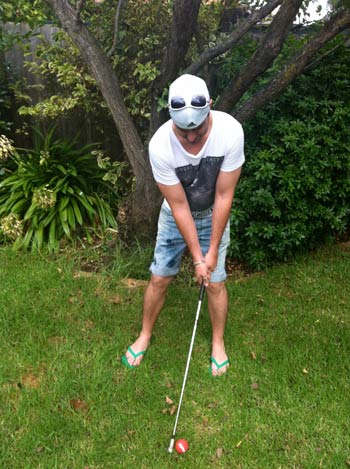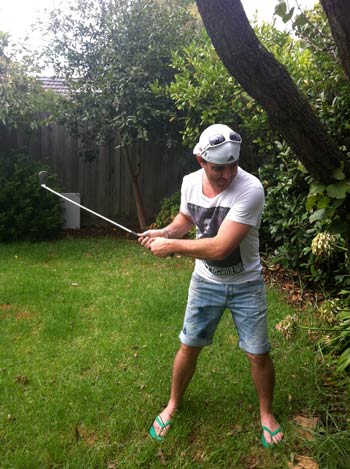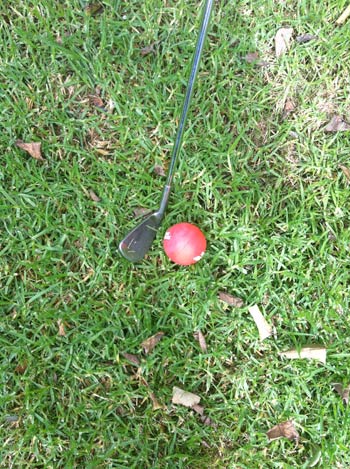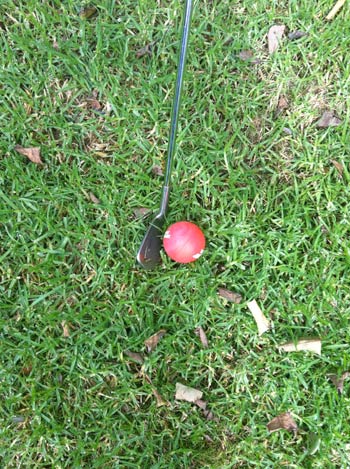Golfers are obsessed with symmetry. When it comes to our game we love to have a square stance, parallel alignment and definitely a square club face. This lesson is meant to challenge you because I’m going to argue that a square clubface may in fact not be want you want to achieve. Here’s the story.
A few years back I spent some time with Kendal McWade. Kendal is a Scottish golf pro with similar ideas to me (it might be fair to say that I was influenced greatly by Kendal). My time with him was fascinating. I spent hours on the practice fairway hitting all sorts of shots, learning to push my boundaries and generally learning things I hadn’t even considered. When we weren’t hitting balls we were talking about coaching and the amazing ability of our natural learning system.
The club face was something Kendal kept harping on about. I probably didn’t fully what he was saying until years later. The reason was a square clubface was something I had considered one of golf’s imperatives – a rock solid fundamental that couldn’t be broken. So although I was having a great time I wasn’t really listening to what Kendal was talking about. Sometimes it takes a while for things to sink in – this is a recurring theme I’m learning with this blog.
But over the years I’m starting to think differently – and there’s nothing off the hit list that can’t be challenged or improved upon. And this includes the clubface because now I have grasped the lesson that Kendal was talking about.
You’ve probably seen, or even used, a baseball type swing to get a feel for a better swing. The usual reason that it’s used is because it’s considered a natural swing. I think there’s a different reason.
And that’s the lack of a specific clubface – because the bat is round you’re not concerned with were you’d strike the ball – you just swing the bat as powerfully as you can.
But give someone a golf club and the magic is lost. The specific club face takes up lot of energy. You’re told to have it square to your target before making your swing, plus you need to think about the exact position of the face at impact (otherwise the ball will go sideways). And this is where the problem starts.
You’re not getting into a powerful position from the start. I’ve seen it time and time again where the clubface gets in the way for the golfer to get into an athletic (and natural) position because they’re so worried about having, and then keeping, the clubface square. Here are some photos that highlight my point.
In the photo above Andrew is in a natural and powerful set-up position. Because he’s using a baseball bat type club (a perfectly round clubface) he is not concerned about is clubface position. In fact, he’s not worried one bit where on the clubface he will strike the ball.
But check the difference in the photo above. Andrew now is thinking about keeping the clubface square at address because the golf club has a very specific face. Notice the much weaker position he is in. This is something I’ve tested over and over and become fascinated with. Why do golfers address the ball better when the typical clubface is removed?
Let’s have a look at how Andrew would attack a tree branch with a stick. This exercise requires no specific thought on where the club should be pointing or which part of the club should strike the tree. The resulting position is athletic, natural and extremely powerful.
Some other things to note: See how this position almost mimics perfectly an ideal top of backswing position. Compare this photo to the one below. In the next photo Andrew is trying to keep the part of the clubface that would strike the tree pointing at the target.
This is a horrible position and one that many golfers get themselves into when they try and strike the ball. I’m convinced that it’s all because many golfers have fallen for the old gotta keep the clubface square trick. It really doesn’t help. Here’s the thing,
The position of your clubface at address in no way determines where it’s going to be at impact
So what’s the answer here?
For a start, try and let your body go where it wants to go. Remember? You’re trying to hit a stationary object with power and accuracy. What’s the most natural position you can get yourself in to do so?
Grab a stick (or something else that doesn’t have a normal golf type clubface) and make some swings. Listen to your body. Go where it wants to go. Don’t be scared to get away from what you’ve been doing with your golf swing.
Then you can try and simulate the same position with your golf setup. And then hit some balls. Here’s what I’ve found.
- You don’t need to have the clubface square at address
- The clubface can be a little open or closed
- Your hands get a little more in front of the ball (this happens naturally because you’re trying to get into a powerful position)
- The ball goes a little further back (I think too many golfers have the ball too far forward – especially with the irons)
And here’s the huge point
Maybe just maybe if you play around with this you may find that if you setup to the ball with an open clubface you’ll do way better. I’m not sure why this works, but an open clubface at address seems to allow golfers to swing more powerfully (and naturally) through the ball. I could have just told you to open the clubface at address but you wouldn’t have understood why I was doing so.
So there you have it. Go grab a club and head out into the back yard and have a play around (this is the best way to learn). I’d be interested in hearing your feedback and any results that you may get.






